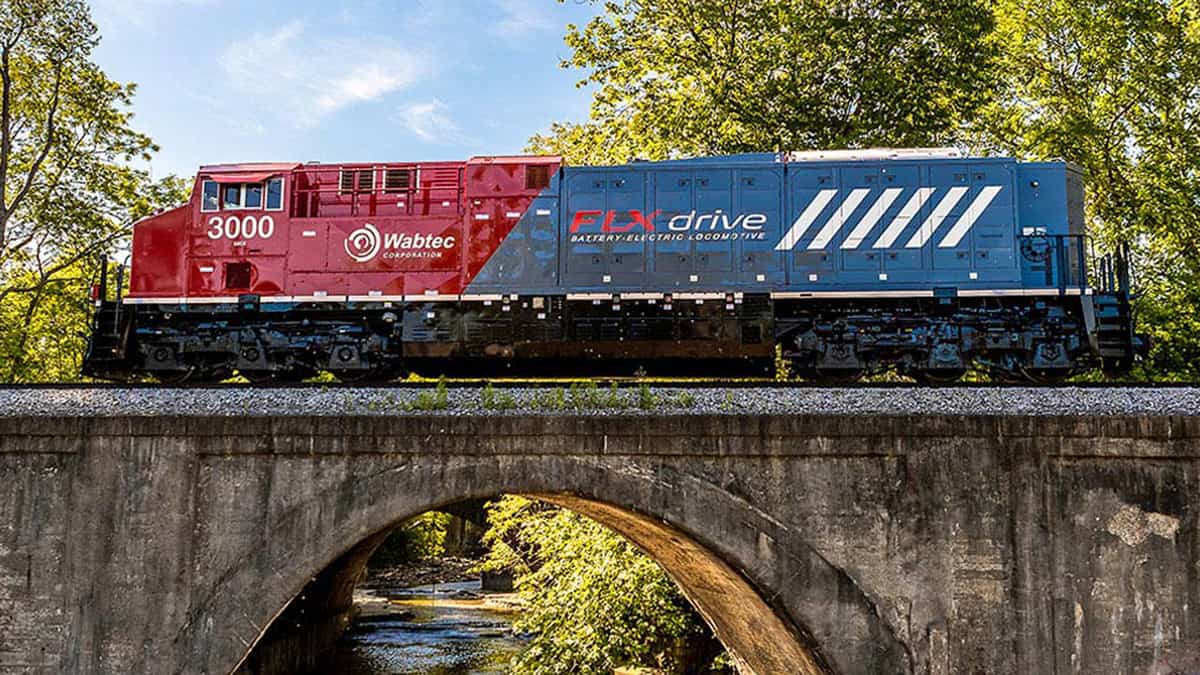Wabtec’s (NYSE: WAB) battery-electric locomotive reduces a train’s fuel consumption by an average 11%, the Pittsburgh-headquartered rail equipment manufacturer and technology provider said Monday.
The FLXdrive, which Wabtec bills as the world’s first 100% battery-powered, heavy-haul freight locomotive, also reduced the train’s greenhouse gas emissions, according to the company. Wabtec was unveiling the results of a three-month study on the locomotive.
“The FLXdrive battery-electric locomotive is a defining moment for freight rail and will accelerate the industry toward low- to zero-emission locomotives,” said Wabtec Chief Technology Officer Eric Gebhardt. “It builds upon the rail industry’s position as the most efficient and sustainable mode of transportation.”
Wabtec conducted the pilot with BNSF (NYSE: BRK.B) in California, with $22.6 million in grant money awarded from the California Air Resources Board to Wabtec, BNSF and the San Joaquin Pollution Control District.
The pilot involved putting the FLXdrive into revenue service, an advanced testing stage, across 13,320 miles in hilly San Joaquin Valley. Wabtec says the region is classified as a nonattainment area, where air quality does not meet National Ambient Air Quality Standards.
The FLXdrive weighs 430,000 pounds, or 215 tons, and uses 18,000 lithium-ion battery cells. The battery locomotive gets charged at the rail yard and recharged during the trip through regenerative braking. Meanwhile, a Trip Optimizer system serves as intelligent cruise control and helps the FLXdrive manage overall train energy flow and distribution. The system uses artificial intelligence to respond to the terrain in an energy-efficient manner.
At the end of the study, Wabtec determined that the FLXdrive helped trains save an average of over 6,200 gallons of diesel fuel and reduce CO2 emissions by approximately 69 tons on average.
“This demonstration of coupling 2.4 megawatt hours of battery storage into the mix fully validated our assumptions for the potential for this next-generation technology to further drive efficiencies and greenhouse gas reductions,” Gebhardt said.
Wabtec says its next step will be to build a second-generation locomotive with a battery capacity of more than 6 megawatt hours.This would reduce a locomotive consist’s fuel consumption and carbon emissions by up to 30%, Wabtec said. A locomotive consist is a group of locomotives.
The company plans to commercialize the second-generation FLXdrive fleet within the next few years.
“At more than 6 megawatt hours, Wabtec’s next version of FLXdrive technology will have an opportunity to reduce fuel consumption and emissions by up to 30 percent — putting the industry on the cusp of a once-in-a-generation improvement in energy savings and emission reductions,” Gebhardt said.
Wabtec is also seeking to develop a zero-emissions locomotive that would use batteries, hydrogen internal combustion engines and hydrogen fuel cells.
The company asked Congress in March for funding to develop a rail technology research and development center. The center would be a public-private partnership among the U.S. government, Wabtec, short line operator Genesee & Wyoming, and Carnegie Mellon University.
Subscribe to FreightWaves’ e-newsletters and get the latest insights on freight right in your inbox.
Click here for more FreightWaves articles by Joanna Marsh.











Greg Hawkins
The contributing reporter failed to include the CO2 emissions created by the “grid” while it charges 18,000 lithium batteries?
How does this correlate to the 69-tons of CO2 emissions saved by the train – what is the DELTA – positive or negative?